Articles and Features · By Shira Wolfe
Stories of Iconic Artworks: Frida Kahlo’s “The Two Fridas”
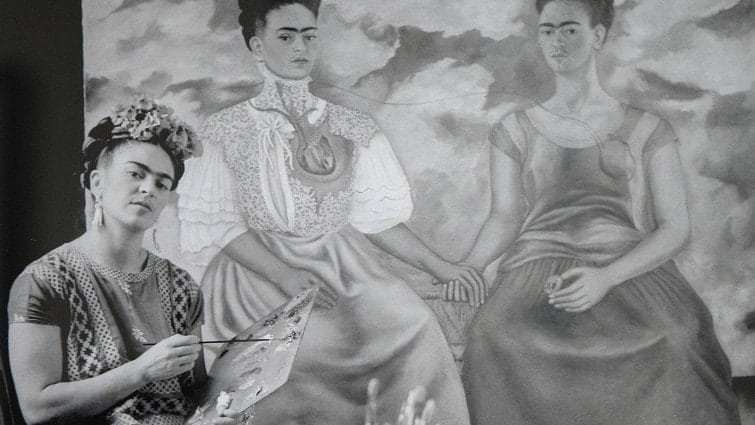
“I paint self-portraits because I am so often alone, because I am the person I know best.”
Frida Kahlo
Double Self-Portrait
Frida Kahlo is one of the most acclaimed artists of the 20th century. Her tumultuous relationship with fellow artist, the Mexican muralist Diego Rivera, inspired countless of her autobiographical works. One of her most iconic ones is “The Two Fridas”, a double self-portrait which portrays two Frida Kahlo’s sitting side by side, one in traditional Tehuana attire and the other in a more modern style. In this edition of our “Stories of Iconic Artworks” series, we explore what lies behind this arresting portrait of the artist.
The Self-Portraits of Frida Kahlo
Frida Kahlo flouted conventions of beauty and social expectations of her time. She lived as an outspoken, flamboyant artist during a time when most women were confined to the kitchen, sacrificing their own ambitions to be a housewife. She also chose to dress mostly in traditional indigenous clothing, a preference of hers which Diego Rivera strongly encouraged and which reflected the traditional roots of her country. In fact, it was particularly since her marriage to Rivera in 1929 that she embraced this indigenous style as her main choice of attire.
In her self-portraits from the 1930s onwards, she frequently portrayed herself wearing such traditional clothes and hairstyles. She has become known for her powerful, unflinching images of herself with her signature moustache and unibrow – never attempting to erase any of these facial features which are at odds with conventional beauty norms. Other topics she often addressed in her self-portraits were her culturally mixed heritage, her difficult but incredibly important relationship with Diego Rivera, and her terrible medical conditions due to a tragic traffic accident she’d had when she was eighteen and a bout of polio. The polio deformed her right leg and the accident left her disabled and infertile. She suffered through 32 complicated operations as a result of the accident. Her own human anatomy is often graphically exposed in her self-portraits, revealing her frustration with her own broken body, as well as her perseverance in the face of this suffering.
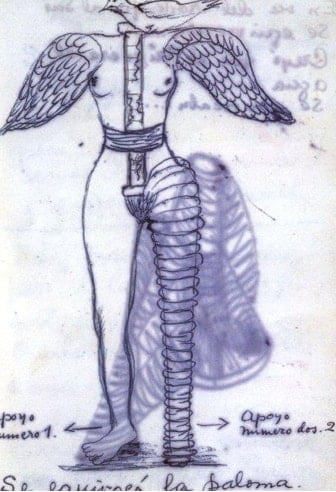
“Anguish and pain, pleasure and death are no more than a process.” – Frida Kahlo
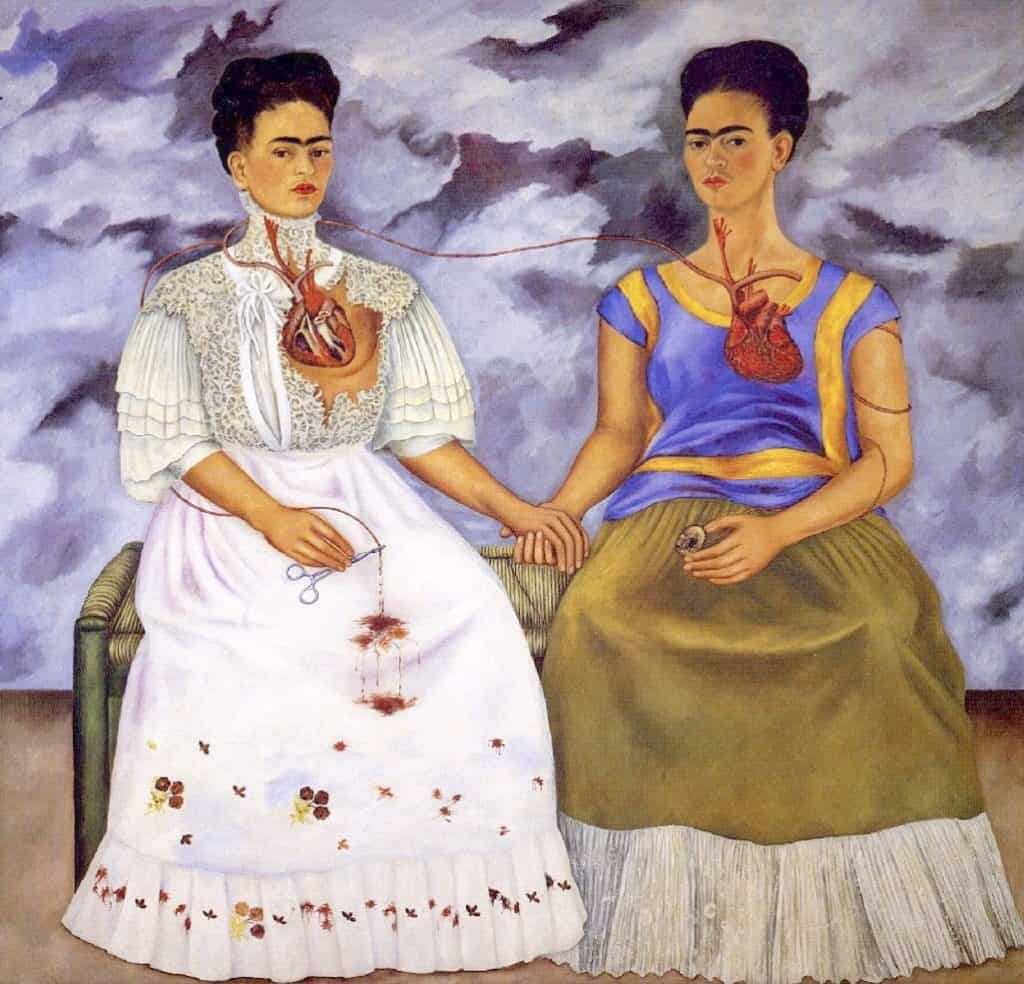
Behind Frida Kahlo’s “The Two Fridas”
“The Two Fridas” was painted in 1939, the year she divorced from Diego Rivera. On the painting, we see two Frida Kahlos sitting side by side as identical twins. Both Fridas’ hearts are revealed. They are distinguished through their attire – the one on the left wears a traditional Tehuana costume, and her heart is cut and torn open, while the one on the right wears a more modern skirt and top. The main artery, which leads from the ripped open heart of the traditional Frida, connects to the heart of the modern Frida, and wraps around her arm, is cut off with a pair of scissors by the traditional Frida. Her white costume is splattered with blood. Meanwhile, the modern Frida on the right holds a small pendant with a portrait of a young Diego Rivera.
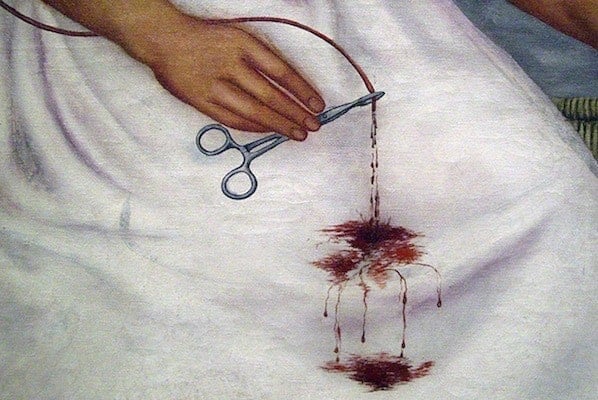
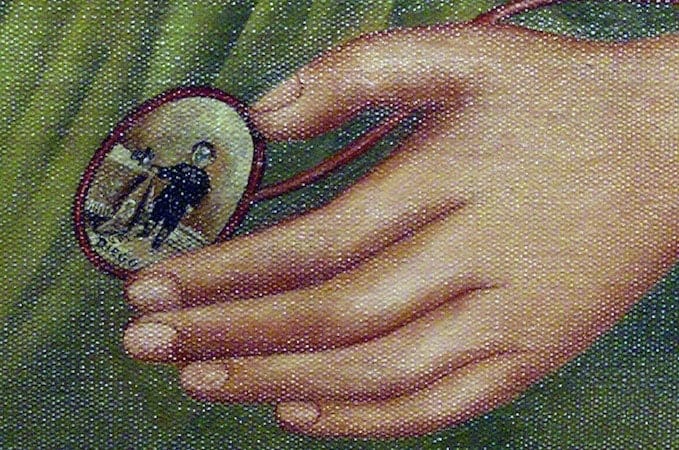
The two Fridas clasp hands tightly, the bond between them enforced by the artery that connects them. They reflect the different parts of Frida: one is weak, suffering from an exposed and broken heart from the separation with Rivera, while the other’s heart is still intact, and clasps onto the portrait of a young Rivera, as if to say she will remember him like this, pure, before he betrayed her. At the same time her heart is also revealed to the viewer, and the double exposed hearts are a testament to her intense emotional suffering.
The sky behind her is stormy, filled with dark clouds that reflect Frida’s inner turmoil. Yet at the same time there is hope in this painting, as she holds her own hands and sits up tall, facing the viewer with an unflinching, powerful gaze.
Frida and Rivera were to remarry in 1940, and continued their lives together until her death in 1954.
What Happened to “The Two Fridas”?
In 1947, “The Two Fridas” was acquired by the Instituto Nacional de Bellas Artes (National Institute of Fine Arts) in Mexico City. The price was 4,000 Pesos (approximately $1,000). This was the highest price Frida was ever paid for a painting during her lifetime.
Today, the painting can be seen at the Museo de Arte Moderno in Mexico City. A reproduction is on display at the Frida Kahlo Museum in Coyoacan, Mexico.
Relevant sources to learn more
Artland Magazine – Art Movement: Surrealism
Artland Magazine – Stories of Iconic Artworks: Diego Rivera’s Rockefeller Mural


